Ship Manoeuvring Performance and Construction of its Metamodels
2015-05-02LIDongqinPhilipWILSONJIANGZhiyong
LI Dong-qin,Philip A.WILSON,JIANG Zhi-yong
(1 School of Naval Architecture&Ocean Engineering,Jiangsu University of Science and Technology,Zhenjiang, China,212003;2 Fluid Structure Interactions Research Group,Faculty of Engineering and the Environment, University of Southampton,Southampton,UK,SO17 1BJ)
Ship Manoeuvring Performance and Construction of its Metamodels
LI Dong-qin1,Philip A.WILSON2,JIANG Zhi-yong1
(1 School of Naval Architecture&Ocean Engineering,Jiangsu University of Science and Technology,Zhenjiang, China,212003;2 Fluid Structure Interactions Research Group,Faculty of Engineering and the Environment, University of Southampton,Southampton,UK,SO17 1BJ)
To improve the efficiency of ship manoeuvring calculation technique,NAPA-based calculations and Support Vector Regression(SVR)were combined to predict the manoeuvring performance of the Offshore Support Vessels(OSV),and enough ship information about the offshore support vessel were gathered;a series of 30 similar hull bodies was adopted by the Latin Hypercube Design which were employed to explore the design space and to sample data for covering the design space.The ship hull series were generated from the affine and displacement transformation and some adjustments in NAPA according to the ship design variables,thus creating the calculation model for the hull geometry expression.For each of the ship models,5 different manoeuvrability criteria were calculated,which were the advance,tactical diameter,transfer,10°/10°first overshoot angle and 20° /20°first overshoot angle.To improve the efficiency of manoeuvring calculation,the Single-parameter Lagrangian Support Vector Regression(SPL-SVR)was adopted and trained to establish the metamodels and predict the manoeuvring performance and this new algorithm was first proposed by the author and combined with Laplace loss function,which has only one parameter to control the errors and adds b2/2 to the item of confidence interval at the same time,For the OSV case,the manoeuvrability criteria were predicted with the SPL-SVR and compared with the NAPA-based calculation results with manoeuvring manager,the Artificial Neural Network results and classical SVR results. The results agreed well with each other.Instead of requiring the evaluation of expensive simulation codes,the metamodels of ship manoeuvring performance were suitable for the practical application in ship preliminary design stage and all the numerical results show the effectiveness and practicability of the new approximation algorithms.
metamodel;Support Vector Machine;ship manoeuvring
0 Introduction
In real world ship design problems,there is often more than one area of element in the overall design;that is,there may be different disciplines that contribute to the ship design[1-2],such as structures,economics,resistance,manoeuvring and seakeeping performance,and so on. How to evaluate these ship performances efficiently is still a research hotspot[3-4].Now manoeuvring performance is considered in the preliminary ship design stage because ship manoeuvrability is directly related to navigation safety and economy.Ship manoeuvrability is the ability for a ship to keep or change motion state under the control actions,i.e.,to keep the straight-ahead course with constant speed,or to change the speed,the course and or the position of the ship,according to the intention of the helmsman.
Each ship will has its own manoeuvring characteristics.The position of the pivot point will vary performance,while performance itself can be affected by numerous factors.The development of new ship design technology is dependent upon a cooperative,multidisciplinary design approach.To reduce the computational cost of implementing computer-based simulations and analyses in ship design,a variety of metamodeling techniques have been developed[5-7],for instance Response Surface Model(RSM),kriging and ANN.Metamodel is a key element of the Multidisciplinary Design Optimization(MDO).In this paper,a new simple and effective algorithm of Support Vector Machines is proposed and used to establish the alternative metamodels of ship manoeuvring to provide the approximation of a design space.
1 Mathematical model of SPL-SVR
Accordingly,it is really important to improve the accuracy and robustness performance of metamodeling techniques especially when the sample size becomes small,limited and scarce. The Support Vector Machines(SVM)[8-10]aims at the limited samples and has a good generalization performance as well as global optimal extremum which have been proved by many researchers[11].In this paper,we will use a new support vector regression algorithm SPL-SVR which is proposed by authors in Ref.[12]to construct the implicit metamodels of ship manoeuvring performance as shown in red frame of Fig.1.The detailed description of this algorithm and its applications can be found in the author’s previous work[12].Here,we will recall the mathematical theory of this algorithm for the readers’convenience and it is named Single-parameter Lagrangian Support Vector Regression(SPL-SVR).The formula is listed as follows:



The above optimization problem can be stated as standard formulized quadratic programming.The dual problem can then be expressed as the following standard quadratic programming form.

Thus,the estimation function is calculated as follows:

With this simpler algorithm,we can obtain the black box which describes the complicated mapping relation without knowing the connection between the dependent variables and independent variables.Therefore,this new algorithm is well suited for the construction of ship manoeuvring approximation model in the preliminary and early-stage design.
2 Establishment of metamodels of ship manoeuvring performance
In this work,the Single-parameter Lagrangian Support Vector Regression is used to establish the metamodels of ship manoeuvring performance,which can reduce the huge calculation cost of the simulation codes and satisfy the growing needs of computation in the multidisciplinary ship design optimization.
2.1 Distribution of ship samples
Before constructing the metamodels of ship manoeuvring performance,we need to gatherplenty of ship information to decide the scope of design variables and select the training ship data set.At the same time,plenty of data about the offshore support vessels were gathered from the shipping companies and design institutions.The distributions of main principal characteristics are showed in Fig.1,in which the red points represent the 30 training ship data from DOE method.
2.2 Design of experiments
Latin Hypercube Designs[13]is adopted here as design of experiments(DOE)to sample out the points of the ship design variables.The Latin Hypercube method chooses points to maximize distance between design points,but with a constraint which maintains the even spacing between factor levels.
As is well known,there are many variables which affect the ship manoeuvring performance.We chose the length between perpendiculars,breadth,depth,design draught,the longitudinal centre of buoyancy,ship velocity and diameter of propeller as the design variables, and these seven parameters can show the geometrical characteristics of ship hull.Also,the standard Model-based calibration toolbox from commercial software Matlab is used to choose 30 testing data set with Latin Hypercube Design and the space distribution of these ship types is showed in Fig.2.Once the fixed parameters are established,the design variables are chosen and we just select 30 testing ships data here listing in the Tab.1.

Tab.1 Design variables of selected 15 training ship data
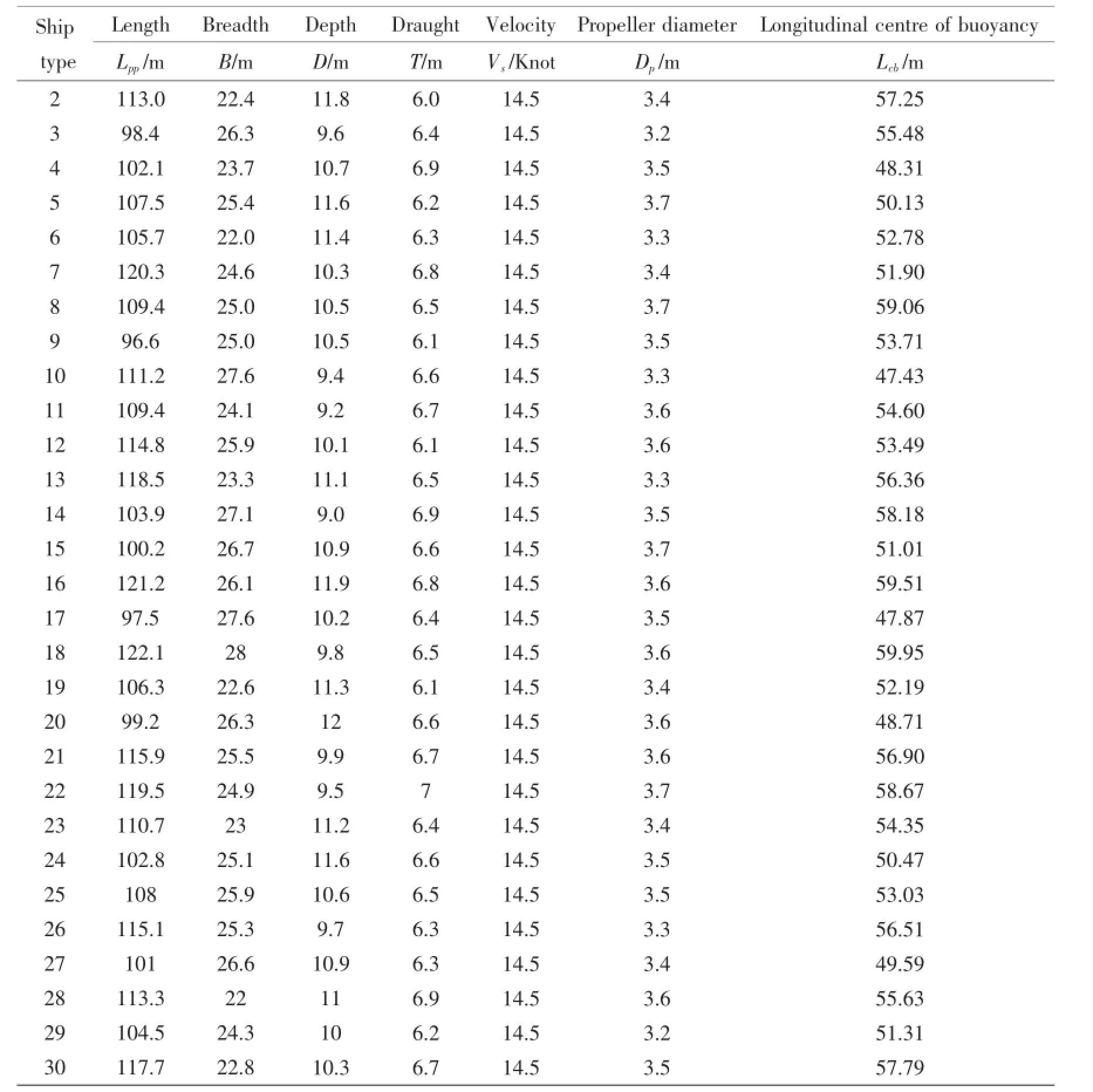
Continue Tab.1
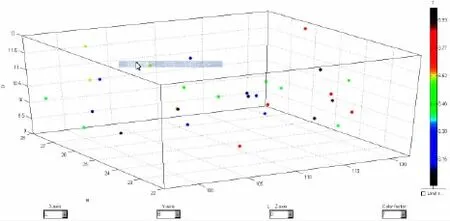
Fig.2 The space distribution of ship training data set
2.3 Establishment of metamodels of ship manoeuvring performance
The ship hulls of these thirty ship samples were generated from the parent ship by thesoftware NAPA within several steps.Firstly,construct the hull of the parent ship in NAPA. Secondly,transform the parent frame area distribution into the needed one according to the difference of the longitudinal coordinates of buoyancy between the parent ship and the design ship.Thirdly,combine the affine and displacement transformation into the design values Lpp, B,D,T under the task TRA in NAPA.Finally,make some adjustments of the ship hull in local place from the personal experience.The ship hull of one training ship is shown in Fig.3.

Fig.3 Transverse section and 3D lay-out of ship hull
Before establishing the metamodels of manoeuvring performance in Multidisciplinary Ship Design Optimization,the ship manoeuvring performance of OSV will be calculated at first. To develop a practical approximation models of ship manoeuvring performance in the hydrodynamic-based multidisciplinary design optimization of offshore support vessel at the early design stage,a practical calculation tool,based on the MMG(Ship Manoeuvring Mathematical Model Group)Model called Manoeuvring Manager from the commercial software NAPA,is used to compute the manoeuvring criteria.
The coordinate systems used in the manoeuvring calculations are as follows:for all input data of manoeuvring devices and hydrostatics,etc,the normal NAPA coordinates are used with X axis starting from the aft perpendicular and the positive Y coordinate to port for the default right handed coordinates;maneuvering derivatives are defined in the manoeuvring coordinate system fixed to the midship;all results for location,velocities,etc,are presented in the manoeuvring coordinate system fixed to the centre of gravity.These coordinate systems and rotations in NAPA are shown in Fig.4.The simulation of turning circle manoeuvre is shown in Fig.5; the simulations of Zigzag tests for different turning angles are shown in Fig.6 and Fig.7.
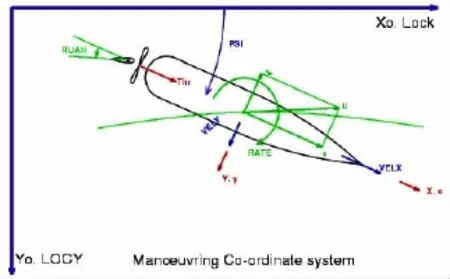
Fig.4 System of coordinates in NAPA

Fig.5 The simulation of turning circle manoeuvre
The International Maritime Organization(IMO)proposed criteria for parameters derived from the standard manoeuvres.These criteria,described in IMO Resolution A.751(18)(1993)[14],are commonly used to judge the manoeuvring characteristics of a vessel.Here we choose advance,tactical diameter,transfer,10°/10°first overshoot angle and 20°/20°first overshoot angle as manoeuvring criteria to evaluate the performance for the offshore support vessel.These calculated manoeuvring criteria of 30 selected ship types are listed in Tab.2.
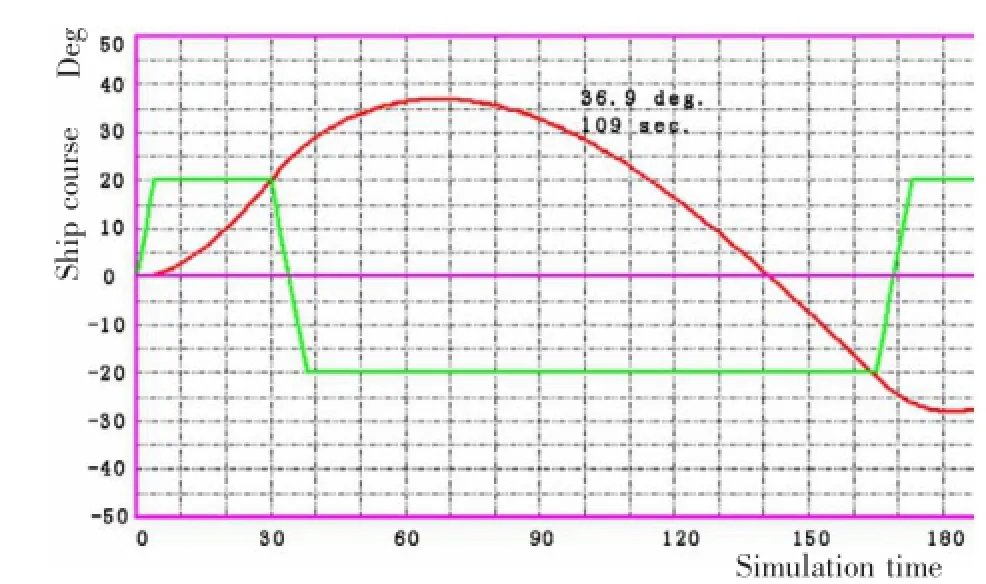
Fig.6 The simulation of Zigzag test 10°/10°
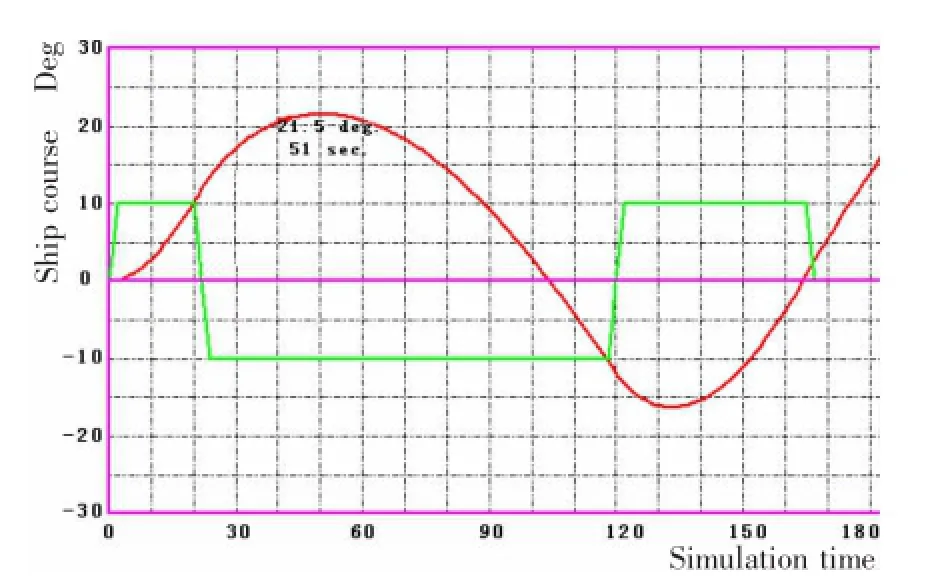
Fig.7 The simulation of Zigzag test 20°/20°
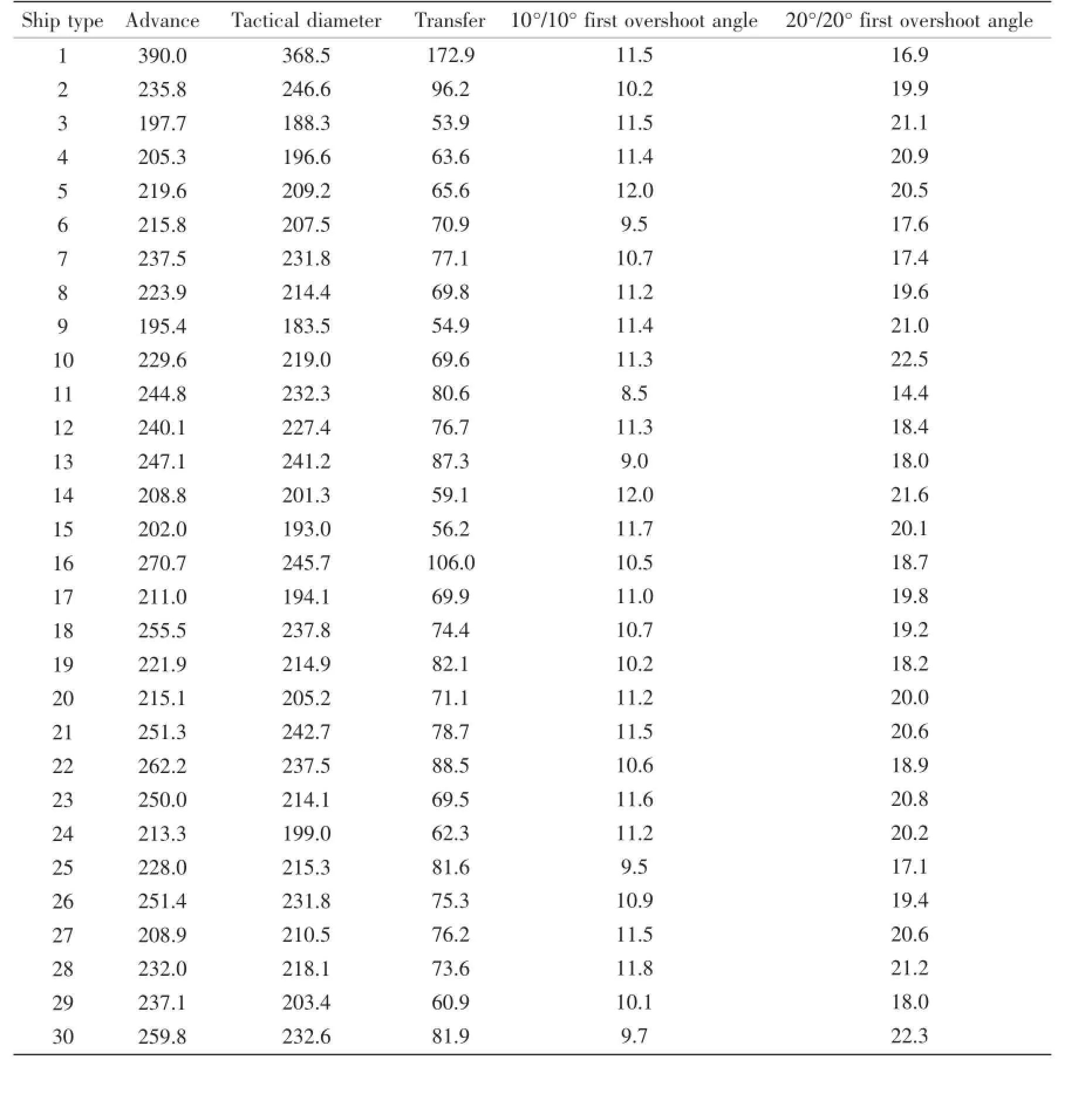
Tab.2 Calculated manoeuvring criteria of selected 30 training ship data
Here,the first 20 ship types created with DOE method are selected as training data set and the last 10 ship types as test data set.The chosen variables are the length between perpendiculars,breadth,depth,design draught,the longitudinal centre of buoyancy,ship velocity and diameter of propeller as the design variables,and the ship advance,tactical diameter,transfer,10°/10°first overshoot angle and 20°/20°first overshoot angle as each output variable.The calculation results were compared with Manoeuvring Manager,ANN and classic SVR which were shown as Fig.8.Here the calculation results for advance and 10°/10°first overshoot angle are just listed in Tabs.3 and 4 for instance.The Relative Error(RE)and Mean relative error(MRE)are applied as performance indexes:


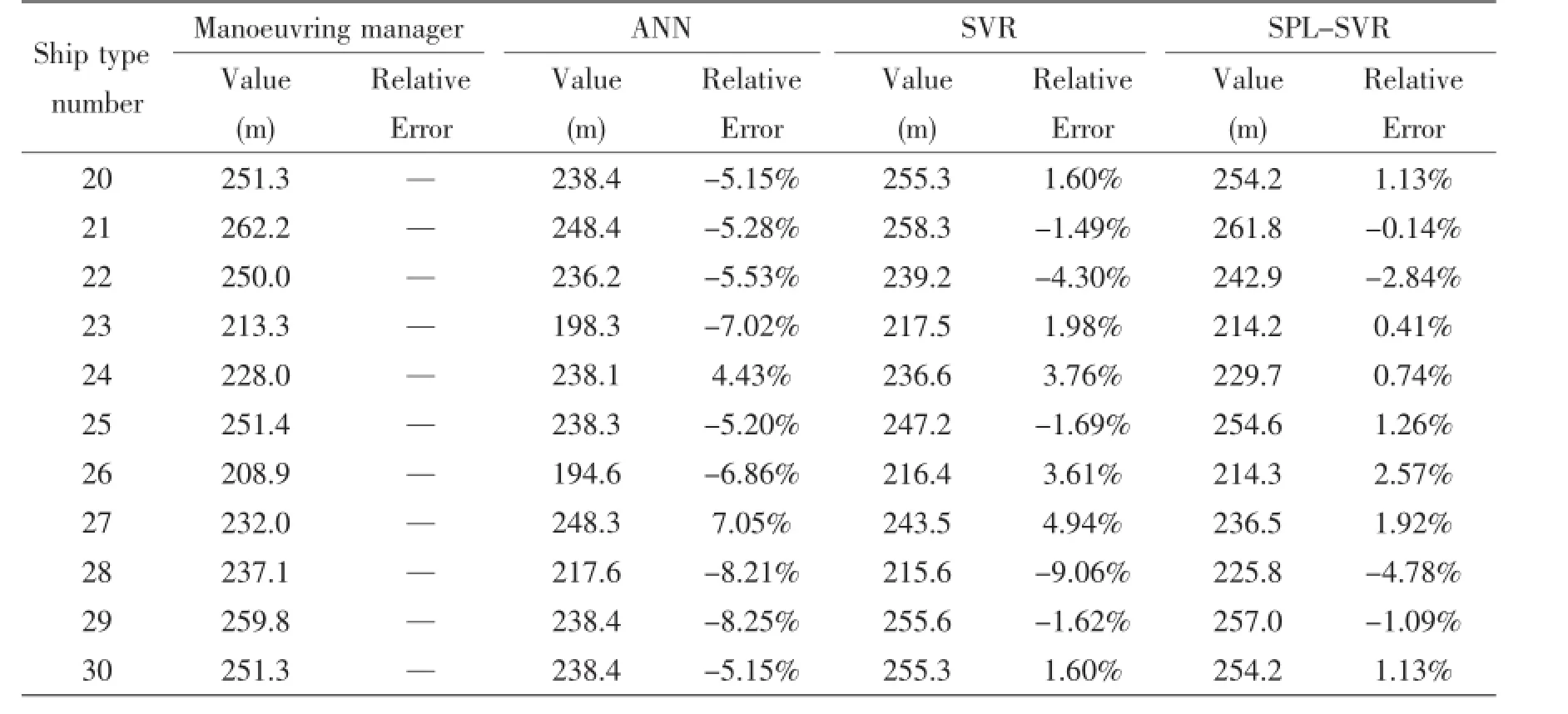
Tab.3 Calculation results with Relative Error(RE)for advance
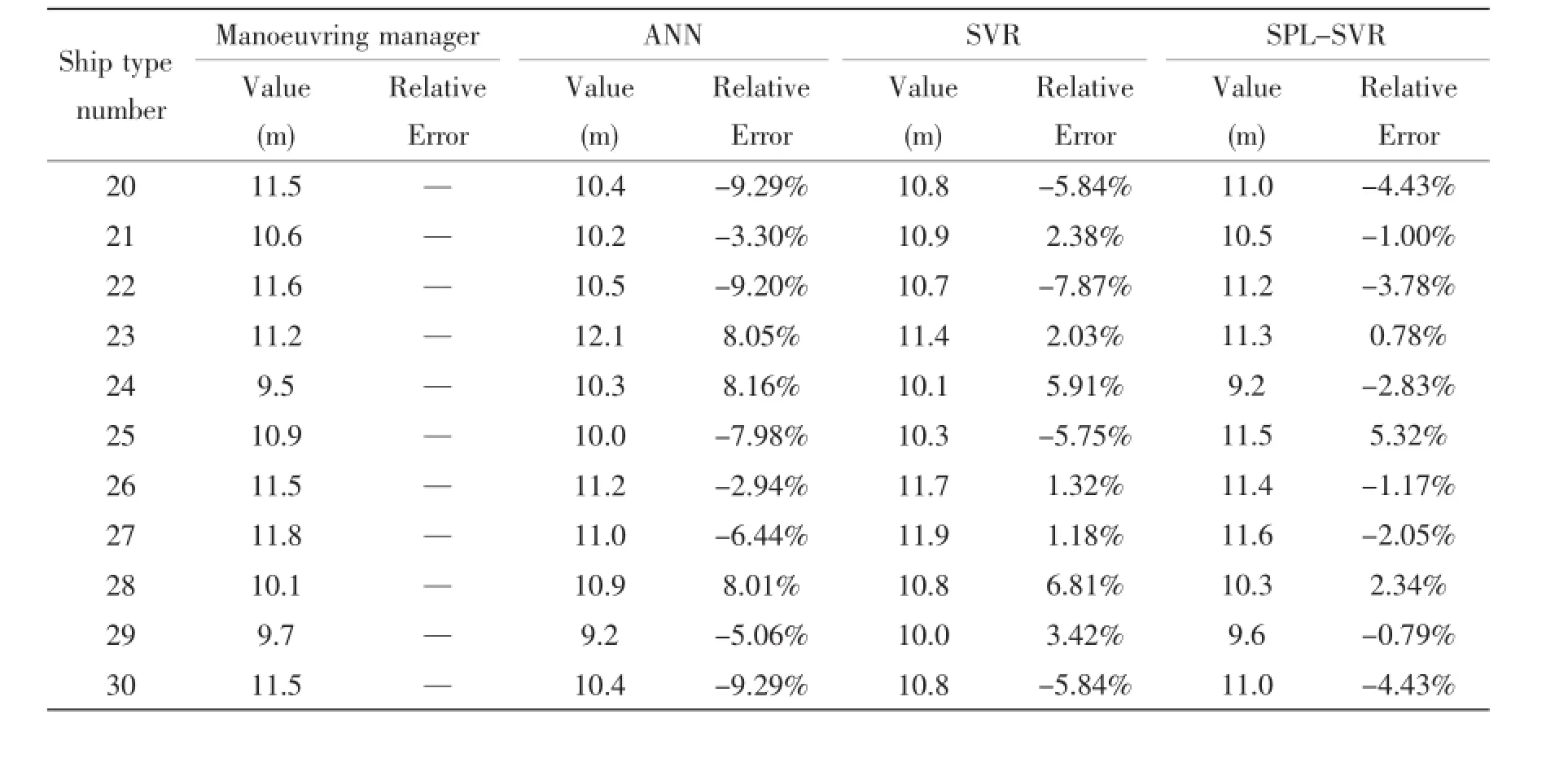
Tab.4 Calculation results with Relative Error(RE)for 10°/10°first overshoot angle
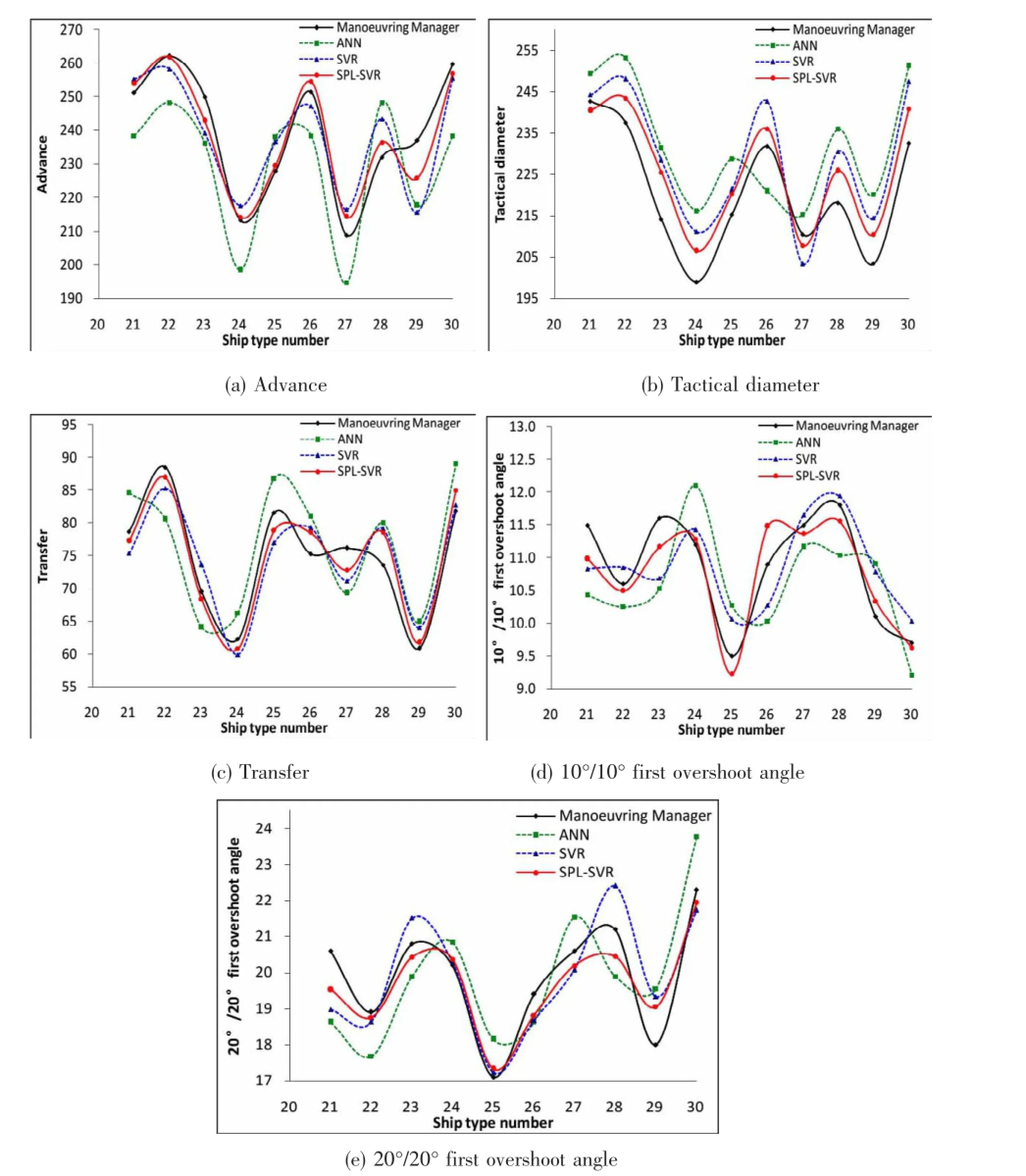
Fig.8 Approximation results of manoeuvring criteria for ship type 20 to 30
Considering the above circumstances,the proposed SPL-SVR algorithm shows a good approximation and prediction performance.The comparison of relative errors is listed in Tab.5. The maximum MRE within the five manoeuvring criteria comparing to the result of Manoeuvring Manager for ANN is 7.77%and the minimum MRE is 5.97%;the maximum MRE for SVR is 4.89%and the minimum MRE is 3.41%;the maximum MRE for SPL-SVR is 3.15%and the minimum MRE is 1.69%.It can be seen that the results are acceptable and agree well with each other.Obviously,if the training ships data set,the kernel parameters and the calculation method for manoeuvring are chosen properly,we can use these metamodels to predict the ship manoeuvring performance in the preliminary ship design stage.

Tab.5 The errors comparison for the five manoeuvring criteria
Using these calculated values of manoeuvring criteria,it is possible to establish metamodels of manoeuvring performance of offshore support vessels in the process of multidisciplinary design optimization.The programs are written in Matlab which are easy to integrate into the Optimus software and the metamodels of ship manoeuvring performance are constructed basing on the proposed Support Vector Regression algorithm.Without running expensive model tests or time consuming CFD calculations,the benchmarking methodology presented in this paper can give an insight of the relationship between input design variables and output responses,facilitate the integration of discipline dependent analysis codes and also reduce the time consumption of computer simulation and saving time in the preliminary ship design stage.
3 Conclusions
The assessment of ship manoeuvring performance is studied in this paper including advance,tactical diameter,transfer,10°/10°first overshoot angle and 20°/20°first overshoot angle.The metamodels for manoeuvring performance established by a new SPL-SVR algorithm in conjunction with LHS are employed in place of expensive simulation and analysis codes and these metamodels can be used to evaluate the ship manoeuvring performance efficiently at preliminary design stages of offshore support vessel.Without using computationally expensive methods such as CFD or model tests,the main advantage of this methodology is that it can provide detailed and realistic operational profiles of ship designs at an early stage of the design process.
As part of the future work,metamodels of ship resistance,seakeeping and manoeuvring can be combined in the framework of Multidisciplinary Design Optimization to improve its convergence efficiency.Multidisciplinary and multiobjective optimization design problems widely exist in the field of ship design,development of effective optimization framework for multidisciplinary and multi-objective problems can be also considered as a future research direc-tion.Additionally,model tests and high-precision simulations of manoeuvring performance will be undertaken in case to enhance the calculation precision of those metamodels for offshore support vessels.
Acknowledgments
The authors wish to thank The Natural Science Foundation of Jiangsu Province of China (Grant No.BK2012696)and the Project funded by the Priority Academic Program Development of Jiangsu Higher Education Institutions(PAPD)for their financial support.The author also would like to thank Prof.Philip A.Wilson for his constructive and insightful suggestions and comments.
[1]Campana Emilio Fortunato,Fasano Giovanni,Peri Daniele.Penalty function approaches for ship multidisciplinary design optimisation(MDO)[J].European Journal of Industrial Engineering,2012,6(6):765-784.
[2]Cui Hao,Osman T,Philip S.Learning-based ship design optimization approach[J].CAD Computer Aided Design,2012, 44(3):186-195.
[3]Woodward M D.Evaluation of inter-facility uncertainty for ship manoeuvring performance prediction[J].Ocean Engineering,2014,88:598-606.
[4]Broglia R,Dubbioso G,Durante D,Di Mascio A.Simulation of turning circle by CFD:Analysis of different propeller models and their effect on manoeuvring prediction[J].Applied Ocean Research,2012,39:1-10.
[5]He Jim,Hannapel Shari,Vlahopoulos Nickolas.Multidisciplinary design optimization of ship hull forms using metamodels [C].Proceedings of the ASME Design Engineering Technical Conference,2011,5:847-856.
[6]Xiao Mi,Gao Liang,Shao Xinyu,Qiu Haobo,Jiang Ping.A generalised collaborative optimisation method and its combination with kriging metamodels for engineering design[J].Journal of Engineering Design,2012,23(5):379-399.
[7]Hesham G,Chu Xuezheng,Gao Liang,Li Peigen.An approach combined response surface method and particle swarm optimization to ship multidisciplinary design and optimization[C].IEEE International Conference on Industrial Engineering and Engineering Management,2009:1810-1814.
[8]He Wei,Zou Zaojian.A Lease Square Support Vector Machine Metamodel for ship performance in uncertainty quantification study[J].Journal of Ship Mechanics,2013,17(6):604-615.
[9]Siamak M,Tillmann F,Suykens Johan A K.Approximate solutions to ordinary differential equations using least squares support vector machines[J].IEEE Transactions on Neural Networks and Learning Systems,2012,23(9):1356-1367.
[10]Vapnik V N.Universal learning technology:support vector machines[J].NEC Journal of Advanced Technology,2005,2 (2):137-144.
[11]Liu Changde,Zhang Hua,Han Yang,Shi Chao.Black-box modeling and prediction of ship maneuverability based on least square support vector machine[J].Journal of Ship Mechanics,2013,17(8):872-877.
[12]Li Dongqin,Guan Yifeng,Wang Qingfeng,Chen Zhitong.Support vector regression-based multidisciplinary design optimization for ship design[C]//Proceedings of the 31th International Conference on Ocean,Offshore and Arctic Engineering,2012,June 10-15.Rio de Janeiro,Brazil,2012.
[13]Fabian Fuerle,Johann Sienz.Decomposed surrogate based optimization of carbon-fiber bicycle frames using Optimum Latin Hypercubes for constraineddesign spaces[J].Computers&Structures,2013,119:48-59.
[14]IMO Resolution A.751(18)[M].Interim Standards for Ship Manoeuvrability,1993.
船舶操纵性能及其代理模型构建
李冬琴1,Philip A.WILSON2,蒋志勇1
(1江苏科技大学船舶与海洋工程学院,江苏镇江,212003;2南安普顿大学工程与环境学院,流体结构耦合研究组,英国南安普顿,SO17 1BJ)
为了提高船舶操纵性能计算效率,文章结合基于NAPA计算仿真结果和支持向量回归方法预报海洋平台支援船的操纵性能,在收集足够相关船型信息前提下,采用能够合理探索设计空间和抽样的拉丁超立方方法获取了30条样本船型数据。通过NAPA仿射变化、位移转换及根据船型设计变量进行局部调整从而生成系列船型以表达船体几何形状。针对每个船型,分别计算了5项操纵性衡准指标:进距、战术直径、横距、10°舵角第一超越角和20°舵角第一超越角。为提高船舶操纵性能的计算效率,文中利用作者早先新提出的一种单参数Lagrangian支持向量回归算法来训练并构建代理模型以预报船舶操纵性能,该算法整合了Laplace损失函数,仅采用单参数控制计算误差并于置信区间中增加了b2/2项。以海洋平台支援船为例,采用SPL-SVR算法预报船舶操纵性能,并与基于NAPA计算仿真结果、人工神经网络、经典支持向量回归算法进行对比。不需要昂贵的仿真代码计算,文中采用SPL-SVR算法建立的船舶操纵性能响应面模型比较适合船型初步设计的工程实际应用,并具有较好的效率和适用性。
代理模型;支持向量机;船舶操纵性
U661.33
:A
李冬琴(1979-),女,江苏科技大学船舶与海洋工程学院副教授;Philip A.WILSON(1954-),男,英国南安普顿大学流体结构耦合研究小组教授;
1007-7294(2015)12-1463-12
U661.33
:A
10.3969/j.issn.1007-7294.2015.12.003
蒋志勇(1956-),男,江苏科技大学船舶与海洋工程学院教授。
Received date:2015-05-22
Foundation item:Supported by the National Natural Science Foundation of China(Grant No.51509114); the Natural Science Foundation of Jiangsu Province of China(Grant No.BK2012696)
Biography:LI Dong-qin(1979-),female,associate professor,E-mail:mandy_ldq@163.com; Philip A.WILSON(1954-),male,professor.
猜你喜欢
——福船
杂志排行
船舶力学的其它文章
- Active Control of Low-Frequency Sinusoidal Vibration Transmission of Ship Machinery
- An Analytical Model of Ballistic Impact on Light Ceramic/Metal Lightweight Armours
- Analysis on Factors Influencing Strains of Unbonded Flexible Risers Under Pressures
- Tensile Fatigue Test Method for Typical Stiffened Panel
- Theoretical and Numerical Research on CTOD for Ship Plate under Cyclic Loading Considering Accumulative Plastic Strain
- A New Concept of ETLP and Its Hydrodynamic Performance
